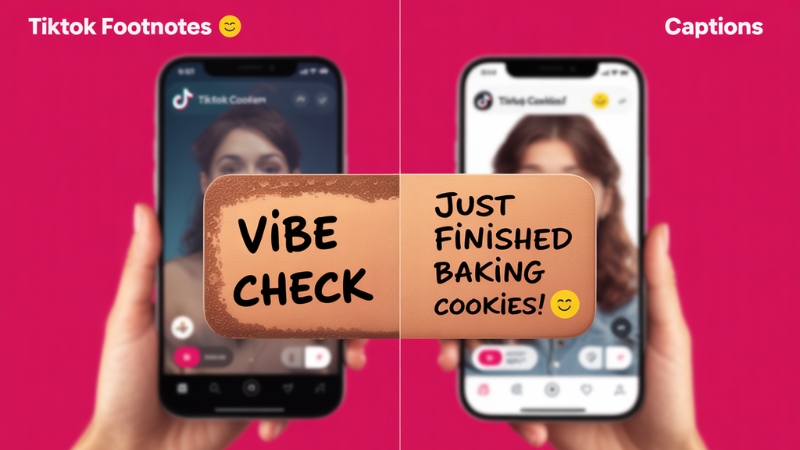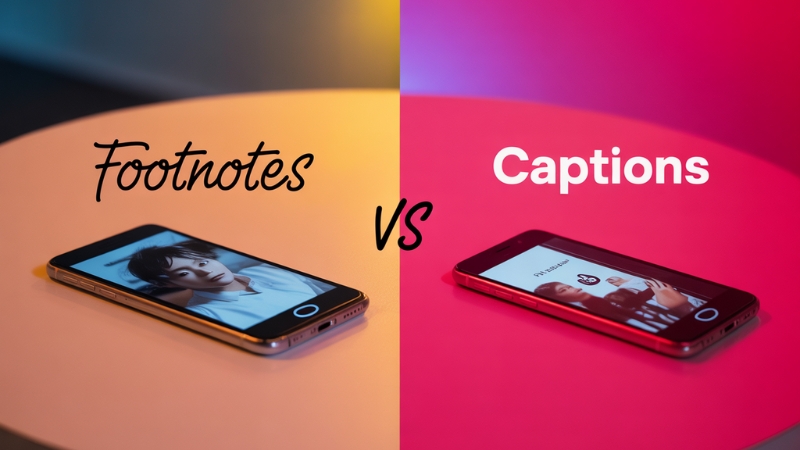TikTok Footnotes vs. Captions: What’s the Difference?

If you are a creator on TikTok, you’ve likely seen footnotes and captions. At first, they might even seem to be the same — they both make it possible to include text inside your videos.
But when you learn how they each work, you’ll see that they put their emphasis on different elements.
SMMGen will explain to you what each of them does and how each of them will help you grow on TikTok.
What Are TikTok Captions?
The lines of text on your video are captions. You control what they say, where they go, and when they show up. They make it easier for viewers to see what you’re talking about, even if they can’t hear you.
Many TikTok users watch videos out in public, with their phone on silent. Captions make sure you still get your message through.
When do you want to caption?
- Highlighting what you're saying
- Summarizing the video’s main idea
- To emphasize an important point or quotation
- Taking viewers through do-it-yourself how-tos or advice
What Are TikTok Footnotes?
Footnotes are among TikTok’s more recent features. They let you include tiny scrolls of text at the bottom of your video. Unlike captions, they’re not timed to speech or synchronized to the main part of your video.
Footnotes are useful for:
- Providing additional context or facts
- Citing sources or data
- Making a wise remark or saying something only in jest
- Crediting without taking away from the video
The Core Differences

Your videos can have both paginated captions and footnotes, although they add text to your videos in slightly different ways.
Captions are included in the body of the text. They tend to be timed to your voice or some action on your part, and they can appear anywhere on screen. They are terrific for elucidating a story, a lesson, reaction.
Footnotes remain on the bottom and provide the reader with additional details.
When to Use Captions
- You should use captions when:
- You are talking to the camera
- You are teaching tips, advice, or instructions.
- Your audio may be unclear.
- Get attention in the opening seconds.
- You want your statement to be loud and obvious
When to Use Footnotes
Footnotes work best when you need to back up your content with more information. They provide background or light explanations without pulling the attention away from the video’s primary visuals.
Use footnotes when:
- You’re mentioning something that would benefit from a short fact or source
- You’re reacting to another video.
- You’re submitting a subtle comment or joke.
- You’re producing educational or commentary content.
Creators in categories like education, politics, pop culture, news, and opinion will find footnotes to be effective. They reaffirm to the viewer that your content is calculated, researched, or factual, without being overwhelming.
Can You Use Both in One Video?
Yes, and you should. Captions and footnotes serve different purposes, and when used together, they come together to make for a better video.
For example:
- You use captions to emphasize what you’re saying
- You can use a footnote to cite your source or insert a quick joke.
The key is balance. Avoid a cluttered text on the screen. Decide what you most want to show, and where to put it so that your content remains clean and easy to watch.
How They Affect Engagement
Both features can increase engagement in different ways.
Captions help:
- Capture their attention in the first few seconds
- Increase watch time
- Appeal to more viewers with the sound off.
- Increase clarity, particularly for those who talk quickly.
Footnotes help:
- Gain trust with your content
- Here, you want them to engage in conversation, so provide a little more info.
- Support sympathetic viewers who crave depth but not added effort.
- Shares and saves should go up if your footnote contributes useful or surprising information.
If you’re looking to expand your following, generate more comments, or earn more trust with your audience, mastering both is worth it.
For proven strategies to increase your TikTok views this year, check out our guide How to Get More Views on TikTok in 2025.
Tips for Better Captions
Here are some best practices for using captions effectively:
- Keep your sentences short
- Use simple, clear language.
- Do not cover your face or important parts of the video.
- Time it to your speech.
- Use bold type to emphasize only the most significant words or concepts.
You can even play around with text size, location, and color. Just be certain that your captions are easy to read.
Tips for Better Footnotes
Footnotes work best when they feel helpful, not distracting. Here’s how to use them well:
- Either maintain formality or be encouraging
- Employ them to address typical questions preemptively.
- Include links, names, or sources as necessary.
- Don’t cram the bottom of the screen.
- Ensure that your footnotes are relevant to your topic.
You can also use footnotes to convey humor, give credit to others, or provide follow-up thoughts without needing to say them out loud.
To understand which feature boosts your TikTok engagement more, check out our detailed comparison in TikTok Duets vs. Stitch: Which One Drives More Engagement?.
Why Choose SMMGen?
- We follow real-time trends in the USA
- We provide you with proven content strategies that can work for you too.
- We explain TikTok’s new features, such as footnotes, captions, and more.
- We assist creators of all sizes, from soon-to-be-baked-through-the-rock people to established brands.
- We care about what matters: genuine engagement, not fake views.